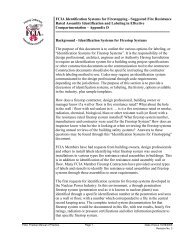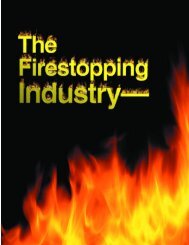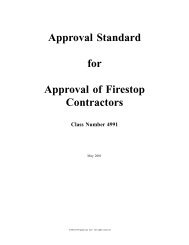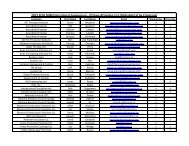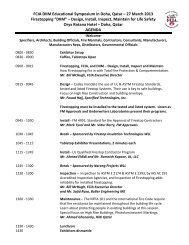Winter 2007 - FCIA - Firestop Contractors International Association
Winter 2007 - FCIA - Firestop Contractors International Association
Winter 2007 - FCIA - Firestop Contractors International Association
Create successful ePaper yourself
Turn your PDF publications into a flip-book with our unique Google optimized e-Paper software.
Code Corner<br />
The ICC 2006/<strong>2007</strong><br />
Code Cycle Starts<br />
The <strong>International</strong> Code<br />
Council's (ICC) code development<br />
process started with code<br />
change proposals, submitted<br />
March 24. Changes were heard at<br />
committee meetings, Sept. 17 to<br />
Oct. 3, 2006, in Orlando, Fla.<br />
The committees represent various<br />
disciplines from Fire Safety,<br />
Means of Egress, Energy, General<br />
and other categories. Consisting<br />
of about 20 people, code change<br />
committees include industry representatives,<br />
building officials and<br />
fire marshals.<br />
The committee hearing process is<br />
dynamic. Each committee hears a<br />
proposal from an individual or<br />
organization for two minutes, testimony<br />
in support of the proposal for<br />
one minute, testimony in opposition<br />
for one minute, then rebuttal<br />
and re-rebuttal if needed. After the<br />
committee discusses the proposal<br />
and shares information with the<br />
assembly, a vote is taken to approve<br />
or disapprove the proposal.<br />
A floor vote can be called if<br />
there is disagreement with the<br />
committee's decision, with all in<br />
attendance allowed to vote.<br />
Public comments can be submitted<br />
if an individual or group<br />
disagrees with a committee action<br />
on a particular proposal. Public<br />
Comments are due Jan. 24.<br />
After being published in manuscripts<br />
available at ICC's website,<br />
at http://www.iccsafe.org, the<br />
public comments are debated<br />
publicly at Final Action Hearings<br />
May 19-27 in Rochester, N.Y.<br />
The debate takes place in front<br />
of the complete assembly of building<br />
officials, fire marshals, and the<br />
industry. However, only building<br />
officials and fire marshals are<br />
allowed to vote.<br />
Successful code change proposals<br />
become part of the <strong>2007</strong> supplement.<br />
The next code change cycle<br />
starts with proposals due Aug. 20.<br />
ICC Code Change Hearings<br />
In the compartmentation industry,<br />
there were several code changes<br />
proposed to make the building and<br />
fire codes better.<br />
The National <strong>Association</strong> of State<br />
Fire Marshals, ICC Code Chapters<br />
throughout the country, California<br />
Fire Chiefs, <strong>International</strong> <strong>Association</strong><br />
of Fire Chiefs, <strong>International</strong> Union of<br />
Fire Fighters, and those industries<br />
affected by code change, were all present<br />
in Orlando, Fla. Sept. 20 - Oct. 3.<br />
NASFM Corridor Code Change<br />
Proposal<br />
The National <strong>Association</strong> of State<br />
Fire Marshals (NASFM) submitted a<br />
code change that called for returning<br />
fire-resistance-rated corridors as<br />
they were in the Uniform Building<br />
Code (UBC).<br />
In code change E-128 during the<br />
Means of Egress debates, NASFM's<br />
Bert Polk proposed that all corridors<br />
in Table 1017.1 become at least one<br />
hour fire-resistance-rated systems<br />
and assemblies. This would provide<br />
safer egress for building occupants,<br />
while allowing firefighters protected<br />
access into the building fire area,<br />
regardless of where it was located in<br />
the building.<br />
Testimony in support came from<br />
the Lorin Neyer of California's<br />
Office of Statewide Health,<br />
Planning and Development<br />
(OSHPD). <strong>FCIA</strong>'s Bill McHugh<br />
also testified with statistics showing<br />
that both sprinklers and compartmentation<br />
are needed in<br />
buildings to support total fire protection.<br />
The committee voted<br />
against the code proposal.<br />
In a related change, Neyer submitted<br />
the same type of change,<br />
but in only healthcare occupancies,<br />
rather than all occupancies. This<br />
proposal was also voted down.<br />
<strong>FCIA</strong> submitted nine code change<br />
proposals focused on three things-a<br />
definition for compartmentation;<br />
proper design, installation, inspection<br />
and maintenance; and systems in the<br />
building and fire codes. <strong>FCIA</strong> requested<br />
a definition for compartmentation,<br />
used language from Chapter 9<br />
Sprinkler Fire Protection asking that<br />
compartmentation be “properly<br />
designed, installed, inspected and<br />
maintained” in the first set of<br />
changes. The third code change was<br />
simply to add the word systems to<br />
Fire-Resistance-Rated construction<br />
Chapter 7, reflecting what the real<br />
world refers to our industry, which is<br />
tested and listed systems.<br />
All three concepts were supported<br />
by NASFM, California Fire<br />
Chiefs, <strong>International</strong> <strong>Association</strong><br />
of Fire Chiefs, Door Safety<br />
Council, Door and Access Systems<br />
Manufacturers <strong>Association</strong> plus<br />
the Door and Hardware Institute<br />
and Door Safety Council. <strong>FCIA</strong>'s<br />
code change proposal for adding<br />
“systems” concept to the code was<br />
successful and passed through<br />
committee.<br />
17 Life Safety Digest 1/<strong>2007</strong>



